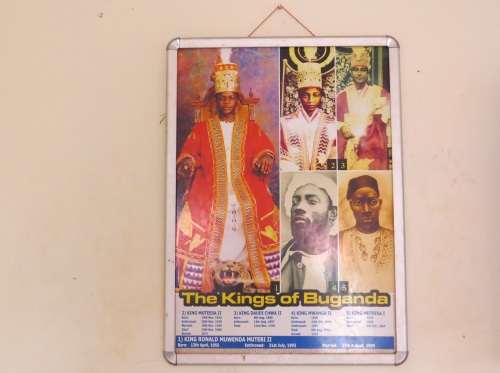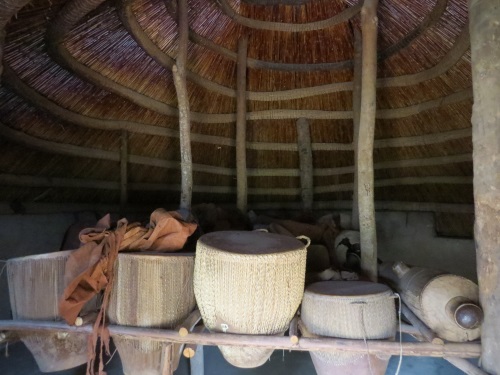The ‘Kasubi Tombs’, as the
Tombs of the Buganda Kings are known locally, may be the only tourist attraction of Kampala (a capital city with 2.5 million inhabitants). And then came that devastating fire on March 10, 2010: the main thatched structure with the 4 tombs of the former kings and their regalia
burned to the ground. The cause is still unknown: was it arson or was it struck by lightning? Anyway: it hasn’t been rebuilt yet. Still I found it an interesting site, and it is an easy place to visit shortly before leaving Uganda via Entebbe Airport.
 |
The 5 most recent kings of Buganda: the 4 to the right were buried here.
The current king is the one on the left |
The tombs are situated on a hill about three kilometers outside of Kampala city centre. Due to a traffic jam my minibus from Entebbe had a hard time reaching the bus station, so I got out somewhere along the way and approached a
boda-boda. The guy immediately understood where I wanted to go, and we took off zigzagging through the dense traffic. There are even a
few signs along the way to announce the proximity of a world heritage site, a small detail that always makes me happy.
One enters the site through the only original thatched building that remains after the 2010 fire. There are two guards at the door opening, each associated with a different Buganda clan that is in charge of security. The modern entrance including guest book and ticket seller is a little further inside the compound. There they tell me that women are required to wear skirts, but they do have a wraparound cloth that I can use to cover my pants.
After the formalities (there’s a 10,000 UGS / 2.5 EUR entrance fee), I was introduced to a guide who would give me a tour of the site. The tour begins with the story of the origins of this place. The Buganda kingdom dates back to the 13th century, and since then there have been 36 kings. During the English colonization in the 19th century they lost their worldly power. With the exception of a few brief intervals during the dictatorship of Obote and Amin in the 1970s and 80s, they have nevertheless kept their ceremonial function until today.
 |
| Thatched entrance hut to the site |
The
destroyed structure, an eight meter high circular building with a thatched roof, was the centerpiece of the site. The progress of reconstruction is slow. According to the guide that is caused by the many ceremonial rules that have to be followed. But the costs were an obstacle too: Japan recently has chipped in, and it is expected that at the end of 2016 the large thatched dome will be resurrected again.
This main building is located on a circular plaza, with
rows of houses around its edge. These houses belonged to the favorite widows of the deceased kings. The first king had as many as 84 women. Even today the descendants of the widows live on the property. There is a kind of village at the back where 35 people live permanently, and there is arable land for them to grow some food.
At the far end of the site lies a cemetery where members of the royal family are buried. This is similar with the tradition of the Toro, whose tombs I visited a few days before near Fort Portal. Just like the Buganda, the Toro are one of the four remaining traditional kingdoms in Uganda. I'm glad I had been able to enter the Toro tombs and
see the ceremonial possessions of the deceased kings, because here in Kasubi these have largely been lost during the fire.
Near the exit lies the Royal Drum House. Drums are kept here that are used for ceremonial occasions, such as a visit of a member of the royal family or a death. Women cannot enter here, but you are allowed to take pictures from the doorway. This restored house shows how the reed layers are attached to make a thatched roof.
 |
| Interior of the Royal Drum House |
My half hour guided visit ended at the shop where they sell paintings on bark cloth. They are pricey but seem done well to my untrained eye (I did not buy one). The tradition of the Buganda is closely connected with the production and use of bark cloth. The cloth fabric is made from the soft bark of the fig tree – there are still a few of those trees at the Kasubi complex and the guide had shown me these. Bark cloth has been manufactured in Uganda for centuries (until the introduction of cotton by Arab traders), and it represents Uganda's sole entry on the
UNESCO Intangible Cultural Heritage List.